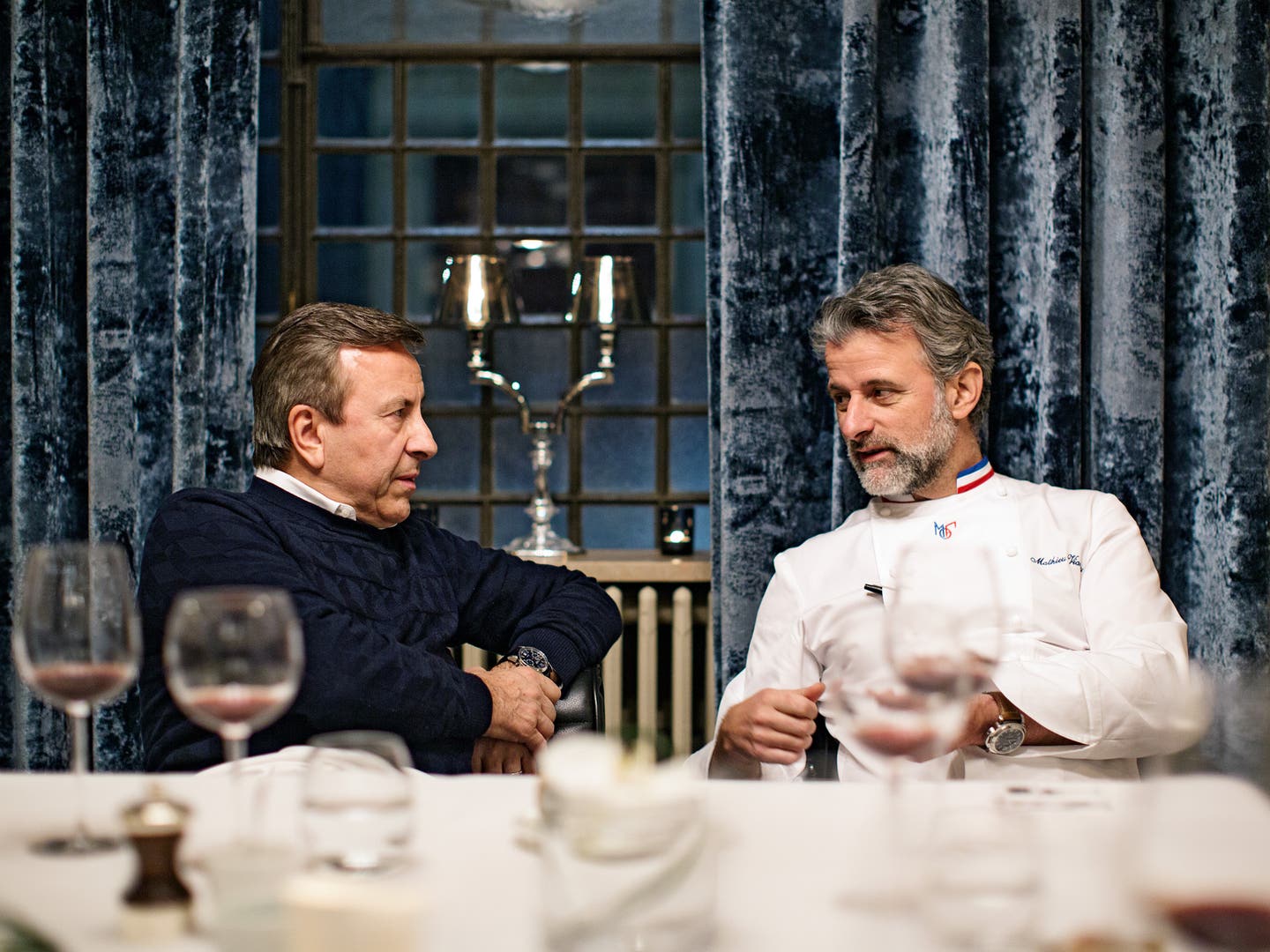
Don’t Mess With the Food of Lyon
Adam Sachs eats around town with hometown hero Daniel Boulud in the gutsy gastronomic capital
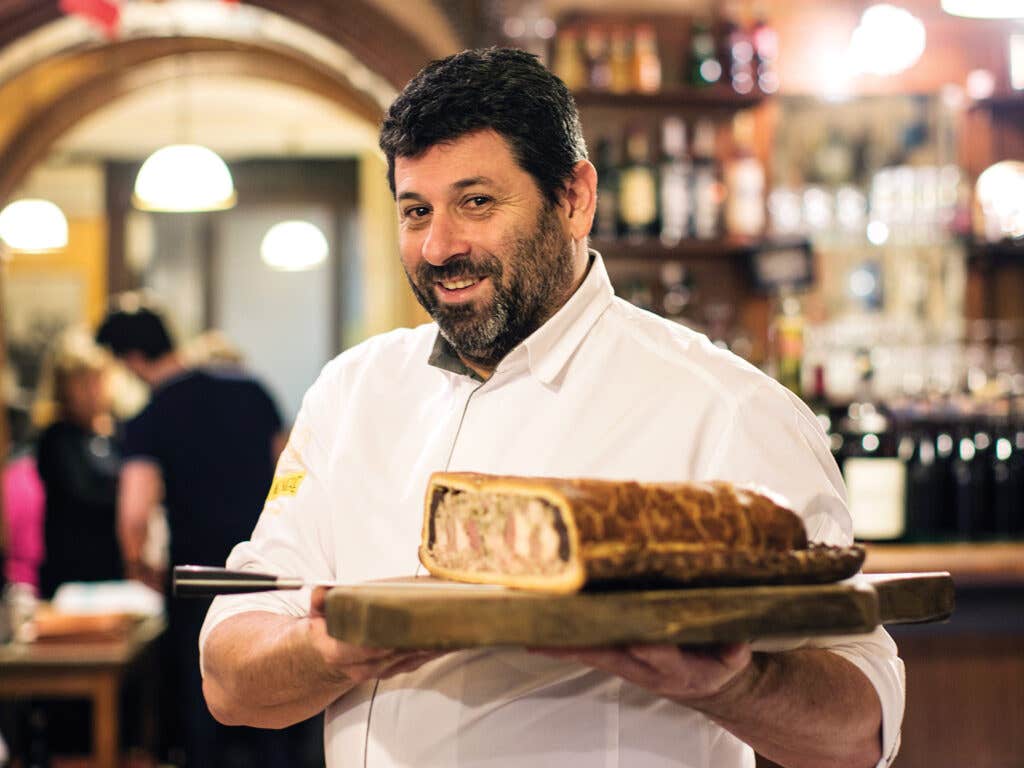
A bouchon is not a bistro.
Bistro: a term deprived of meaning, splashed about globally, indiscriminately. Toulouse has bistros. So, too, Tuscaloosa and all points in between. The bouchon, by contrast, is a fixed type, a local phenomenon, stubbornly immutable even as the world around it insists on changing. The bouchon does not travel. Only here—where the snaking Rhône and Saône rivers meet, and the charcuterie shops in the old town are hung with swaddled, pear-shaped pork sausages called Jésus de Lyon and the windows of the pâtisseries piled high with the distinctive hot-pink pralines that figure into nearly all local pastry variants—do we encounter this endemic species, the true workingman's bouchon lyonnaise. What does it look like? Not much. Plain butcher's paper over red-and-white-checked tablecloths. Buttery light on plastered peach-colored walls hung with chipped enamel strainers, whisks and ladles, posters advertising extinct liqueurs and Marcel Pagnol films, patinated copper pots and garlands of drying garlic.
And at the center of the room, anchoring it, or circulating with the chatty patrons, pastry-bound multi-meat pâtés so massively voluminous they are named after pillows.
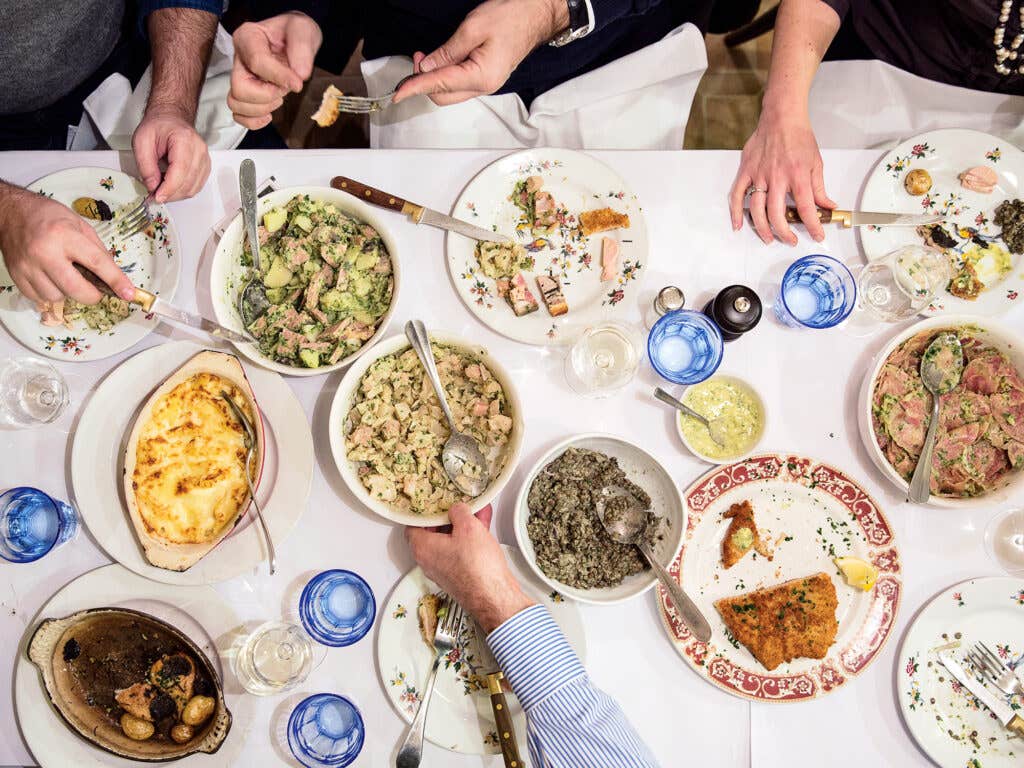
Quality of fare varies, but there is a comforting conformity of ritual in these establishments. They are built to welcome, to err on the side of over-feeding. Bouchon means "bottle stopper" and there is certainly wine here, lots of it and none very fancy. (A local partisan once noted, approvingly, that, in addition to the bodies of water mentioned above, the city was served too by a "third river, the Beaujolais, which never dries up and is never muddy.")
There's another explanation for the name: Bouchonner un cheval refers to the act of brushing a horse with straw.
"In the old days these were places where you could have your horse cleaned and fed and you could also get a little bite," Daniel Boulud said, quickly glancing at the menu at La Munière. The bouchon menu is not meant to be lingered over or debated. One just orders a lot of everything, much of it shared in communal, all-you-can-eat platters and cocottes. That evening we began with a frisbee-sized slice of the house terrine, or oreiller ("pillow").
“Foie gras, Guinea hen, chicken, duck gelée,” Boulud said, itemizing the pillow's layers. He took a sip of wine and continued: “truffle, duck heart, the rest of the duck…”
Boulud, the celebrated king of French gastronomy in New York, operates a posh constellation of restaurants in Manhattan, Singapore, Palm Beach, and beyond. But Lyon is where he is from, where he studied and mastered his craft and it's the food of this region that runs in his blood. The first Café Boulud operated on the family farm in Saint-Pierre-de-Chandieu, twelve or so miles southeast of the city. The family Boulud hunted, raised cows, pigs, goats, chickens, squab, and rabbits; made wine; and sold their cheese, vegetables, and eggs at market. The only thing imported was fish, which was bought off a truck that drove by on Fridays.
“I wanted to get out of the farm so bad!” Boulud said, smiling. The grow-your-own self-sufficiency—fetishized and in vogue now—would have felt cloying to a starry-eyed 14-year-old trainee peeling carrots in the kitchen at Nandron, then an estimable Michelin two-star temple on the quai Jean-Moulin.
Boulud is the most unstoppably curious, energetic, and gracious of chefs, which is why he allowed himself to be lured away from his parents' farm and vacationing family for a series of meals during which I pestered him with a trio of repetitive questions: What's so great about Lyonnaise cuisine? Why does the rest of this prideful country allow this one city to proclaim itself as The Gastronomic Capital of France without putting up a fight? And: Could you please pass the pig's snout salad?
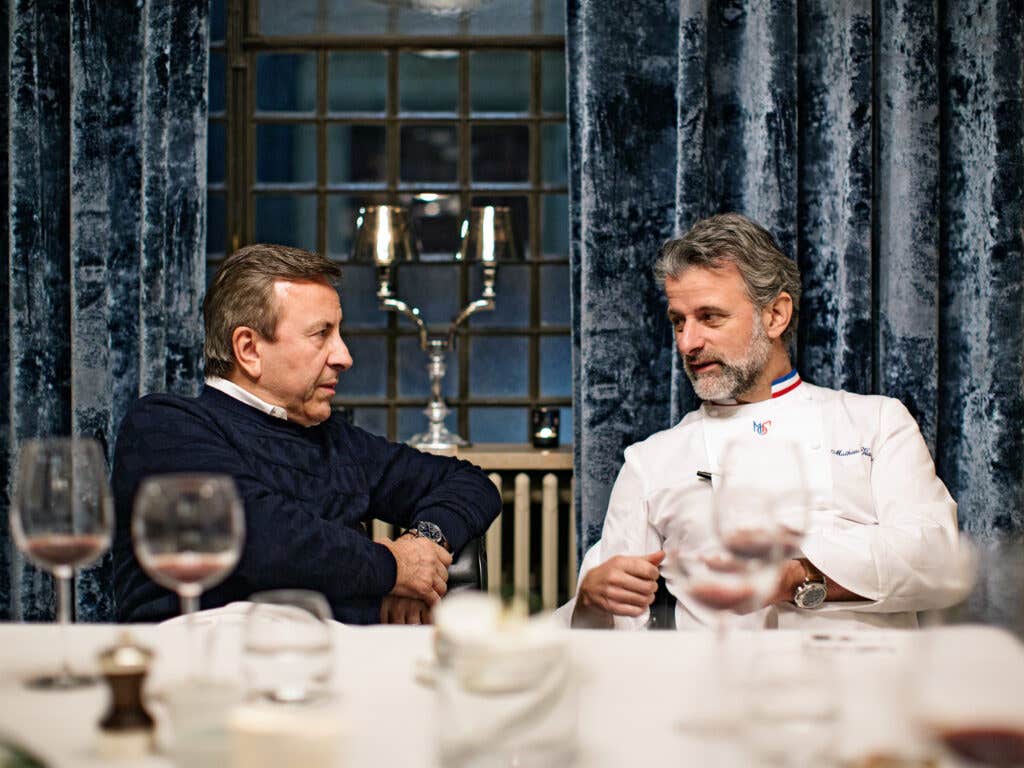
Geography and supply, Boulud advised, were keys to understanding its place in French cooking.
"The bounty of the region created a cuisine that's rich in diversity. All around there is wine. You have the poulet from Bresse nearby, the brochet, or pike, coming from the rivers and lakes, crayfish, frogs legs," he said.
“South of Lyon it is California, a garden all the way down to Provence. North there is the bounty of vegetables and to the west, mushrooms and Charolais beef.”
"In Paris the cooking was fancier, more refined but it was a different clientele," he said. "Here it was the cuisine bourgeoise. The food was gutsier, not so cheffy."
Hungry for un-cheffy things, I mentioned the snouts. “Ah, the schnoz,” Boulud said, enthusiastically. “Rolled, poached, and sliced thin.”
The mustardy salade museau was part of a perverse onslaught of platters that soon filled the table. Jellied veal trotters, lentils, cervelat (a dense and delicious pink boudin) and potato salad tossed with more saucisson. We had no horses but these "salads" alone would have fed a calvary.
“Don't get comfortable!” Boulud advised the table. It was our first day in Lyon. We were filling up too quickly, like amateurs. Anyway, we were already late for our second dinner of the evening.
The first chef in France to be awarded Michelin's highest three-star rating for two restaurants at the same time was not the globetrotting restaurateur Alain Ducasse in the 1990s, but a stout and feared Lyonnaise woman named Eugénie Brazier in 1933.
La Mère Brazier as she was known was part of a remarkable lineage of female chefs that helped define the culinary identity of the area and make its restaurants legend. It's hard to think of an example (in or out of France, before or since) where a group of women have exerted such explicit, lasting influence on a restaurant culture as the mères of Lyon.
"She had the biggest cojones in all the region," Boulud said admiringly as we entered the elegant quarters of restaurant Mère Brazier on rue Royale for our second dinner. Her restaurant in the country closed years ago and Brazier herself passed away in the 1970s. But her presence is firmly felt, both in terms of her creations still served here (Bresse chicken demi-deuil, or "half mourning," with black truffle tucked under the skin) and the lasting influence over Lyonnaise chefs.
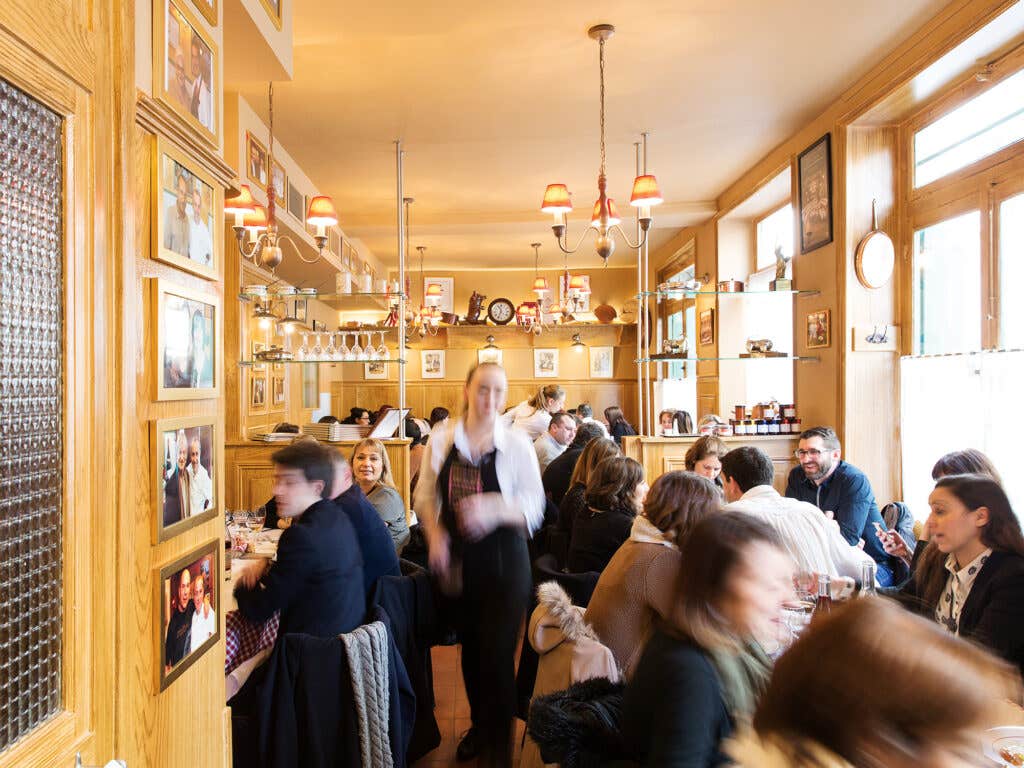
“No other city had a matriarchy like this one,” Boulud said. Many women were working as private chefs for bourgeois families. After the devastations of the first World War, some of these women stepped into the public realm, filling a void left by the men who didn't come home.
"The young chefs who followed, they loved these mothers because they were more macho than the men." We are served another pillow (partridge, wild duck, pheasant—sweeter than the first and more refined) and the truffled poulet in silky sauce suprême by Mathieu Viannay, suave inheritor of Mère Brazier's kitchen.
There's pleasure, even a certain logic, in alternating meals between these high-gloss dining rooms with their pinpoint lighting, table-side service and velvety drapes and the more cluttered, low-ceilinged rooms of the bouchons.
At Mère Brazier the quenelle is called a mousseline de brochet and is served with fingers of lobster meat and an absinthe-laced seafood sauce. It costs €55 and is expertly constructed, elegant, and altogether pleasant. At Daniel & Denise, a bouchon we ate at the next day, a more rustic but altogether serviceable quenelle with sauce Nantua will run you €18 and might easily be the centerpiece of a stabilizing lunch on its own—if, that is, one hadn't signed on for the immersive Daniel Boulud experience. As it happened, chef Joseph Viola (cropped grey hair, blue architect's glasses, sneaky smile) sent out seemingly everything his kitchen knew how to make, much of it exceptional.
I'm a sucker for tripe and Viola's gras-double à la lyonnaise is addictively good, both deeply meaty and buoyantly light, layered with strands of sweet onions and tart with vinegar. Perfectly pink pan-fried calf's liver was followed by an entire saucisson with pistachios, stuffed, like a prison-break weapon, inside a buttery brioche loaf.
"Ok, that's a feast," Boulud admitted. Then the sabodet arrived and a low moan (exhaustion, elation) floated over the table. Sabodet is like a louche French cousin to Italian cotechino, less a cohesive sausage, more a purple-skinned loose amalgam of pork head, skin, and belly meat, braised in red wine.
This is when you really want to be dining with someone like Daniel Boulud. Someone who can speak about the process and seasons and importance of properly seared pig's skin.
"In the winter when you kill the pig it's also the same time you're pruning your vines," Boulud said. "So you burn the pig on a fire made with the vine trimmings. Ideally you are making eau-de-vie too, so you cook the sabodet in the skin and stems of the grapes so there's this wine flavor and alcohol flavor and nothing on the farm is wasted."
It's an eloquent disquisition on a scenario nearly none of us can relate to (pigs, vines, foods dictated by the rhythms of the seasons as opposed to the on-demand desires of hungry travelers).
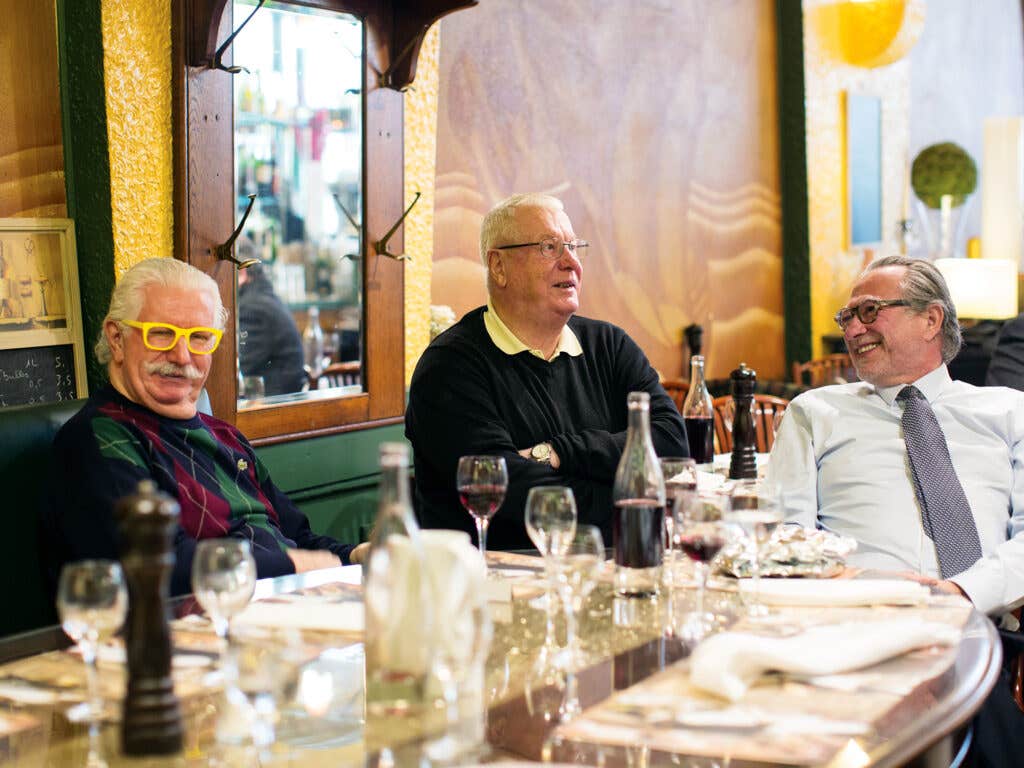
Paul Bocuse's restaurant sits a few miles north of Lyon, on a bucolic compound just past the spot where the Pont Paul Bocuse crosses the Saône river.
Passing through its gates feels a bit like crossing the border into a slightly surreal land of food worship, a Vatican City of haute Lyonnaise gastronomy. A cobblestoned rue des Grands Chefs winds past a lengthy fresco depicting the history of French cuisine: Napoleon through the great Fernand Point, the mères, Julia Child, and leading to the 90-year-old godfather of cuisine nouvelle himself, Bocuse. The maison is green with pink shutters and painted with large images of the crowing rooster, Bocuse's spirit animal.
Bocuse has had three Michelin stars for 50 years. It's understandable to fear that an institution like this would be resting on its laurels—and a great pleasure to realize that i's not.
We pose for pictures with Bocuse in the kitchen, among the toques and gleaming copper, before the great man is lead away.
“We're in the temple of Lyonnaise food now!” Boulud said, as genuinely excited as I've seen him.
We eat poached foie gras on sweet cooked quince; a salmis of Bresse pigeon in a sauce of liver, heart, onion, more foie gras. This is luxury food, indulgent food, but there's nothing dainty about it. It's as lusty in its refined way as the nose-and-feet salad of a bouchon.
A loup de mer, or sea bass, the size of a skateboard is presented to the table wrapped in acres of puff pastry.
"Ah, I cut the lemons and cleaned the loup for this dish when I was a stagiaire here at 15!" Boulud exclaimed, pleased to see a dish he's known in some capacity since 1972.
And the fish—big, buttery, in a sharp sauce Choron—was…perfect. An un-updated throwback worth a dozen new-fangled smeared plates at restaurants you can't remember the name of after you leave.
Cuisine nouvelle was meant to be an answer to the aspic-laden old ways. Now here it was, decades later, preserved in its own kind of protective aspic of time and reverence and pride.
"I think what is special about Lyon is you have this rich cuisine bourgeoise," Boulud said. "And then, you have the bouchons where you really see the talents of the charcutier, the pâtissier, the boulanger. Then you had the mères, and then the legends like Fernand Point, and Bocuse who trained with him. People had money to spend on food because it was an industrial city, plus you had hundreds of incredible auberges nearby in the countryside."
It added up. Here was a culture of eating that is, like the bouchon, specific, local, animated by some proudly out-of-step distillation of pure retrograde Frenchiness.
While we waited for the cheese cart to roll our way, I asked Boulud what Lyonnaise cuisine could teach the world.
“Oh Lyonnaise food don't care a damn to teach the world anything!” he answered, laughing. “As long as they keep themselves happy with what they love the most, they are fine.”
Get the recipe for Meringue Floating in Crème Anglaise (Île Flottante) »
Get the recipe for Calf's Head (Tête de Veau) »
Get the recipe for Ravigote Sauce »
Get the recipe for Pike Quenelles with Sauce Nantua (Quenelles de Brochet) »
Get the recipe for Fromage Blanc Spread (Cervelle de Canut) »
Get the recipe for Lentil Salad with Pork »
Get the recipe for Lyonnaise Salad with Sausage and Walnuts »
Get the recipe for Potato Salad with Herring »
Where to Eat in Lyon
La Meunière
This classic bouchon lyonnaise has been given a gentle makeover by Chef Olivier Canal and his partners.
11 rue Neuve
Le Suprême
Gâteau de foie blonde, pretty chicken liver cake, and tête de veau sauce ravigote are two Lyonnaise classics reimagined at this warm and welcoming modern restaurant owned by husband-and-wife team Yun Young Lee and Grégory Stawowy.
106 cours Gambetta
Café Sillon
Mathieu Rostaing-Tayard turns out inventive, seriously delicious dishes from the small kitchen of this lively neo-bistro with a bit of Scandinavian style. There's something of the Lyonnaise swagger in Rostaing's pairings of delicate rabbit kidneys with purple cabbage, and pork confit with chard and maple syrup.
46 avenue Jean-Jaurès
L'Auberge du Pont de Collonges
Paul Bocuse's restaurant, situated just a few miles north of Lyon, and where he's known as the grandfather of cuisine nouvelle, has had three Michelin stars for more than 50 years, longer than any other restaurant in history.
40 rue de la Plage, Collonges-au-Mont-d'Or
La Mere Brazier
Mathieu Viannay's cooking offers a refined polish on dishes that are elemental and gutsy.
12 rue Royale
Denise & Denise
Joseph Viola's trio of simple but elegant dining rooms offer an exemplary introduction to the classics of a bouchon menu: tablier sapeur ("fireman's apron") which is tripe—pressed, breaded, and fried in the manner of a schnitzel—saucisson in buttery brioche, and perfectly cooked calf's liver.
Multiple locations
What to Drink with Your Lyonnaise Meal
In Lyon, diners mostly gravitate toward robust Côtes-du-Rhône and lots of rounded and textured beaujolais to pair with the region's hearty food. Below are four picks from Michaël Dell'Aira, the general manager and sommelier of Lyon's Le Suprême restaurant.
Clusel Roch Côte-Rôtie (2012 vintage; $50; garnetwine.com): A refined syrah from just south of Lyon, with hints of ripe red fruits (like cherries), truffles, and leather. Serve with red meat.
Yves Gangloff Condrieu (2012 vintage; $100; hitimewine.net): A dry, aromatic white from the viognier grape, with elements of dried apricots, lemon confit, and exotic fruits. Pair with pan-seared foie gras, cooked rind cheeses, and apricot tarts.
Jean Louis Dutraive "Domaine de la Grand'Cour" Fleurie (2014 vintage; $30; mwcwine.com): A superbly elegant and balanced gamay, with notes of kirsch, violet, and iris flower. Pair with sausage, pork, and charcuterie.
Alain Graillot Crozes-Hermitage (2013 vintage; $30; whwc.com): A full-bodied yet softly tannic syrah, with notes of blackberries and spices. Serve older vintages with red meat and younger with charcuterie.
Keep Reading
Continue to Next Story










